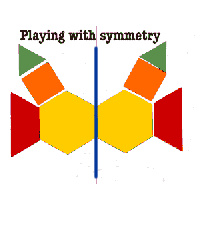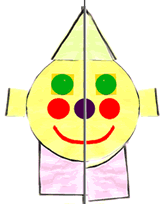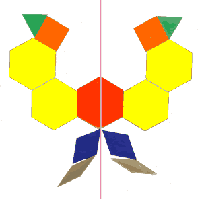When teaching symmetry to young children introduce new vocabulary with hands on activities.
In math, symmetry means that one shape becomes exactly like another when you move it in some way: turn it, flip it or slide it.
When teaching beginners, show them that shapes on one side of a line are the same as on the other side of a line.
Young children begin to understand the concepts and vocabulary of symmetry if you give them time to play symmetry games and experiment with symmetry art.
Simple Symmetry Game

When teaching symmetry have children play the following game with a partner. As always, demonstrate games first.
Materials for 2 kids:
- Pattern blocks
- Dowel rod or largest size tinker toy
- Math mat (place mat sized mat)
Procedure:
-
- Give 2 children one mat
- Place a rod, such as the longest dowel stick in a Tinker Toy set in the middle of the mat
- Child #1 puts one pattern block down on his/her side of the mat touching the rod
- Child #2 copies by putting the same block in the same place but on the other side of the rod
- Continue the game with 5 or six blocks and then remove the blocks
- The children tell each other what they think they have created
- Point out to the children that they have made designs that are symmetrical
- Explain that they are symmetrical because each side of the rod has blocks of the same color and in the same place
- Repeat with child #2 starting the design
- Repeat the game during the next week with new partners, changing it up by enthusiastically telling kids, “Today we’re going to make symmetrical birds (or butterflies or monsters)!”
Integrate symmetry activities into themes
Kids love learning large words. Although they may not get them quite right in the beginning, after playing with symmetry for a week and reviewing it once or twice a month by integrating symmetry into a theme activity, the students soon come to remember new words and the concepts. If you are studying insects, talk about how the wings are symmetrical or in a winter theme, make symmetrical snowflakes.
Teaching symmetry by comparing real things & pictures
If you have real things in your room that are symmetrical show them to the students and ask, “Is this ___ symmetrical? Why or why not?”
If you don’t have real items make simple pictures, some of which are symmetrical and some that are not symmetrical (see image above) with construction paper and shape stickers, then ask the question.
Books such as, Is it Symmetrical? help introduce the concept to children.
Next post – Teaching symmetry with art…



